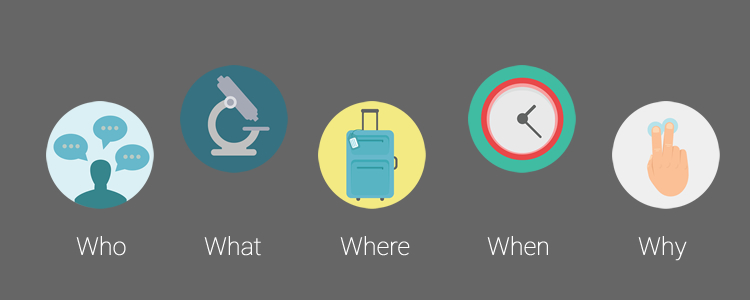
First year journalism students learn about the five Ws (Who, What, Where, When and Why).
Although you may have no intention of becoming a professional journalist, if you’re going to write articles for your blog, then using the Five Ws is a smart habit to get into. The last thing you want a reader to do is to walk away from your blog post scratching his head and wondering why you didn’t completely cover the topic. While the Five Ws may be a bit of a cliche from old-time journalism standards, it is a good place to start. Will every single article you write lend itself to the Five? Not likely. However, running through them may spark another idea for another angle on the story that you hadn’t thought of at first.

Breaking Down the W’s
Old Dominion University provides a chart the is very helpful when going through the Five Ws that you might find helpful. Here are some questions you can ask as you move through each point.
- Who: Who is this story about? Who is the target reader?
- What: What is the main idea of the story? What is going on? What actions did the person defined above take?
- Where: Where is the story located? Where is the person from? Where did the event occur? Where can the information be used?
- When: When did this all take place? When can this information be used? When will the event occur or did it occur?
- Why: Why are you writing about this topic? Why should the reader care?
Who
If you were simply to answer each question posed above, it wouldn’t make for a very long article, would it? In fact, you might even be able to answer all the questions in a single sentence. Instead, you must expand on each point, covering it from all the angles. You want the reader to walk away feeling as though she thoroughly knows the topic and not as if she still has questions that need to be answered.
When you are answering the question of who this post is about, you’ll want to dig deeper and cover questions such as:
- How old is the person?
- Where does this person live?
- Are there any personal facts that pertain to the story?
- Who else was involved in the incident?
- What is the person’s career?
- What is his name?
- What is his job title?
What
What is the main idea of this story? If you were going to tell me in a single sentence what your article is about, what would you say? Are you:
- Arguing a point?
- Explaining how to do something?
- Reviewing or critiquing something?
- Describing something?
Where
Where did the story take place or where could it take place? Dig deep here. since you are covering a location, you’ll want to go into as much detail as you possibly can. Show the reader instead of just telling her. For example, instead of writing that it was a hot day, write that the person’s hair stuck to the back of her neck from the sweat trickling down from her scalp. Let the reader know that the air was hot and sticky. If you can show the reader, you will pull her into your article and keep her there.
- What does the place look like?
- What is it called?
- Are there any smells?
- What are the sounds?
- Are there any little known facts that the reader will find interesting about this place?
When
When did the story take place or when will the event happen? So often any more, I see a great article about an upcoming conference or event and not once in the article does the writer mention the date or time. Pay attention to these details and your blog posts will stand out as solidly researched pieces of writing.
- What is the date?
- What is the time?
- What goes on around the same time? Is it a specific season? Is the whether ideal for this event at that time?
Why
Why are you covering this topic? While you might not come right out and tell the reader the reason you wrote an article, it is important to know your specific reasons for writing about a topic. You also may want to ask why a certain individual did something. While you can’t live inside someone else’s head, you can surmise the reasons behind a person’s actions. Just make sure that you tell the reader this is your analysis. This can be a good opportunity to get readers talking about your posts.
What About How?
Some journalists also pose the question “how?” This is somethings called the Five Ws and an H, or Who What Where When Why and How?
How is inserted throughout your other questions. For example, let’s say that you run a website about concerts coming to your local town. You’re interviewing someone who books shows about an upcoming concert. You might ask when the show starts as part of your “when” questions and then follow up with:
“How long is the show?”
This is an important question that helps to fill in the blanks. It should stem from the natural ebb and flow fo the interview. “How?” can also be used to help explain complicated processes to the reader.
A Case Study

Photo Credit: Crowfly Vienna
Let’s take a look at an age-old story that most people know so you can see how the Five Ws work.
We’re going to look at the story of Little Red Riding Hood. Just in case you’ve not heard this story, basically it is about a young girl whose grandmother is ill. She takes off through the forest to see her grandmother. The little girl wears a red riding cape with a hood. However, before she arrives at Grandma’s house, the big bad wolf shows up and takes the place of her grandmother. His goal? To eat Red, or so the original story goes. But, what is the wolf’s side?
So, let’s say you are writing an article and you are interviewing the wolf. Before you ever begin the interview, you are going to ask the Five Ws to help you prepare.
- Who is this story about? Who is the wolf? Who is grandma? Who is Red?
- What happens to the grandmother? What does the wolf do? What does Red do?
- Where does the story take place? Where is the wolf when Red arrives? Where did Grandma go?
- When does Red arrive at her grandmother’s house? When did the wolf get there? When did Grandma grow ill?
- Why does the wolf want to eat Red? Why does the grandmother let the wolf in? Why doesn’t Red realize it is a wolf and not her grandma?
Now, you are ready to interview the wolf. As you go through the questions above, you might come up with a new take on this story. Something like this:
In an exclusive interview with Mr. Big Bad Wolf, it was discovered that there is more to the story of Little Red Riding Hood than was first thought. In the spring of 1659, the wolf stated that Red and some of her friends started a forest fire which ultimately caused his family to flee from their safe den. In the process, Mr. Wolf’s wife and three children were killed.
“It wasn’t the first time that Red and her hoodlum friends caused trouble for us forest animals, but her actions that day were the same thing as murder. I vowed to get revenge.”
However, it wasn’t until the fall of 1960, when Red’s grandmother grew ill that Mr. Wolf saw his chance to avenge his family. According to Mr. Wolf, he knew that Red liked to take a particular path through the forest to her grandmother’s house. He’d been watching her for six months before the day of the attack. He also knew she would have a basket of baked goods and where her grandmother lived.
When he saw red on her regular path to Grandma’s house, he took a shortcut through the woods. The grandmother loved woodland creatures and happily opened the door to the wolf, but he quickly tied her up, stole one of her nighties and caps and placed himself under her bed covers. He knew that he couldn’t hide his tail, but he hoped Red wouldn’t notice his long snout.
“I waited about ten minutes before she arrived and I told her to come a little closer so I could see her better, because I knew her grandmother had poor vision. Everyone in Red’s family does.”
When Red moved closer to the bed, she realized that the wolf was not her grandmother. She screamed and called for the woodsman she’d seen on her way in and he chased the wolf away.
“I wasn’t going to even hurt her,” Mr. Wolf said. “I was just going to scare her and steal her treats to get back at her a little. I mean, I’m not a monster. I know she’s just a little kid, but I wanted some revenge.”
The wolf is spending five years in lock up for attempted snatching of the elderly woman’s treats.
Do you see how asking the questions helps flesh out your story and engage the reader? While you might not use every single W question every time, having them there as a guide can help you, particularly when you are interviewing people. EduPlace offers a handy chart you can print off and use for planning out your questions before writing a blog post.
Finally, keep in mind that a picture is truly worth a thousand words. How much more powerful does the story above become when you add a picture of Mr. Wolf with his now deceased wife and children? Look at every angle, look at every W, and before you know it you’ll be blogging like a professional journalist.























No Comments